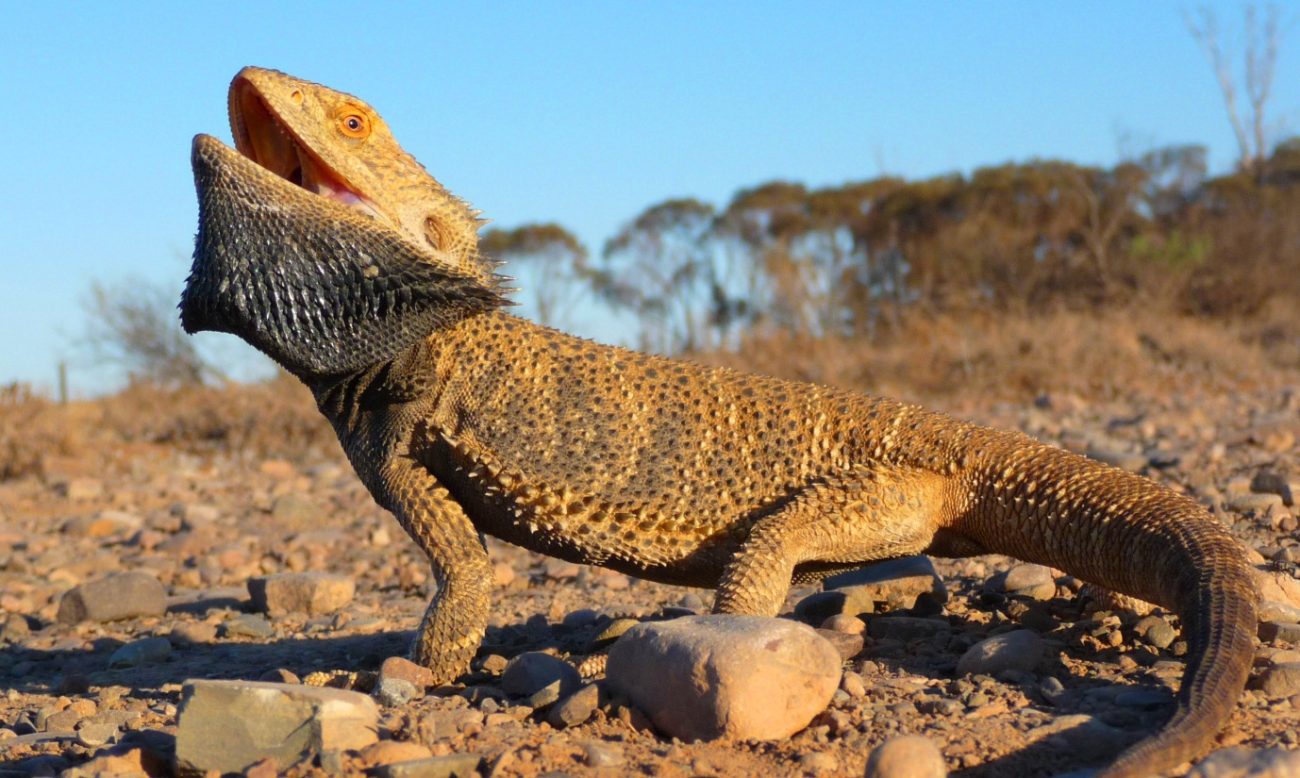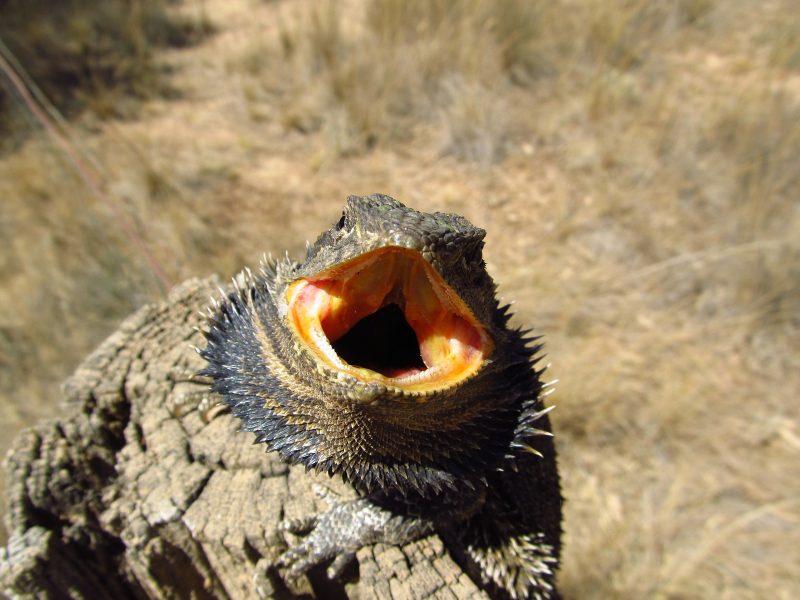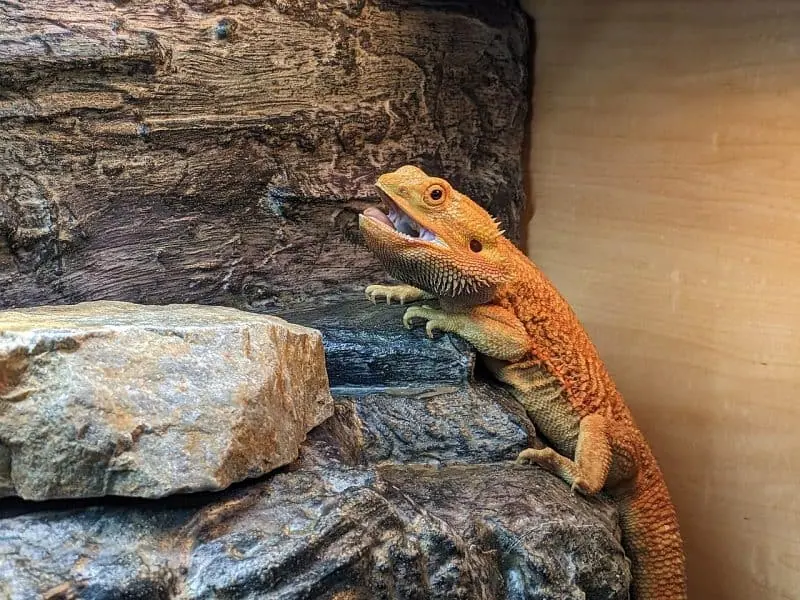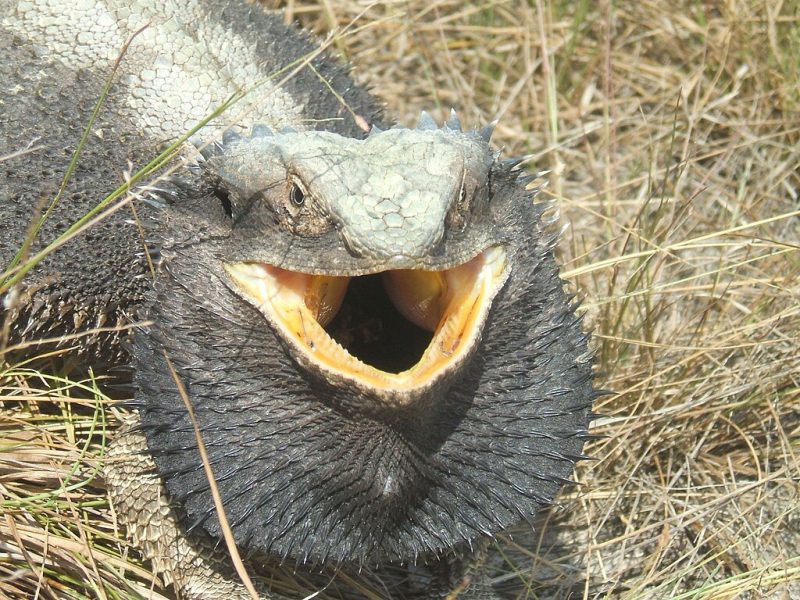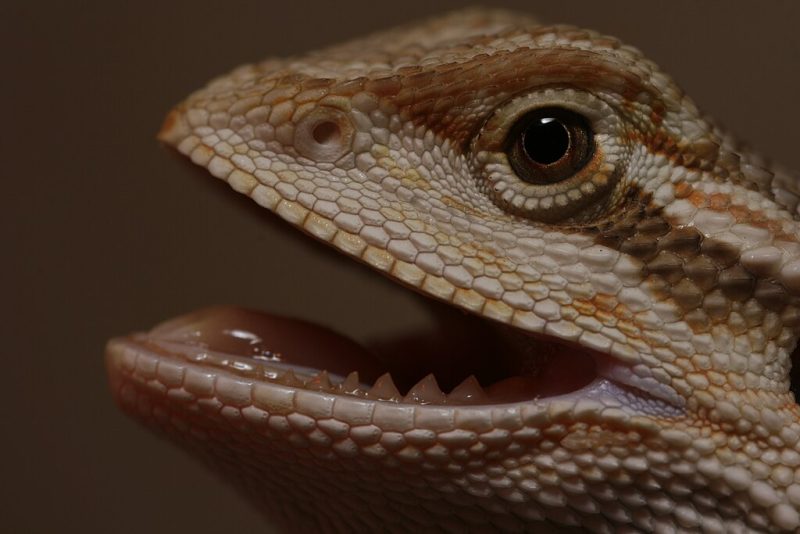So, you notice that your bearded dragon has its mouth open. Should you be concerned? Is it normal for them to do this?
How do you know which of these is the answer? You can do this by getting some context. You want to look at the big picture. Keep reading, and you will discover what signs to look out for. You can unlock the secret to why your pet’s mouth is open.
Regulating Body Temperature
If your bearded dragon opens its mouth while basking, it is likely trying to regulate its temperature. Unlike humans, reptiles are unable to perspire to cool down their bodies. Instead, they must find other means to cool down their bodies.
One of those ways is called gapping. When gapping, bearded dragons will open their mouths. Moisture from your pet’s mouth and throat evaporates, which helps cool its body.
Bearded dragons need to be kept at high temperatures. Your pet’s basking spot should be between 95-110 degrees Fahrenheit. The cooler parts of the enclosure can be kept at the lower 80’s.
Many who keep bearded dragons do not keep them at the proper temperature. For this reason, they do not witness gapping behavior. If your beardie is gapping, you know that you are keeping your pet at a high enough temperature.
Remember, your pet’s enclosure needs a thermogradient. The warmest part of the enclosure should be between 95-110 degrees Fahrenheit. The cooler parts should be in the lower 80’s.
Providing your pet with a thermogradient allows it to choose the best temperature for its needs.
Showing Dominance
Bearded dragons are territorial and solitary by nature. If you keep more than one beardie in the same enclosure, your pet’s open mouth may express dominance, particularly if males are kept together.
Bearded dragons are expressive lizards; their body language expresses their moods. The body language to show dominance may include:
Displaying
Bearded dragons will puff out their beard. Doing this creates a visual display. It makes the beardie appear more intimidating to other males.
Open Mouth
With an open mouth, bearded dragons can expose their teeth. A hissing sound may also accompany the opening of the mouth.
Head Bobbing
Head bobbing is a form of body language that is often used among males. This is especially true with rapid head bobbing, often used in defending territory or showing dominance during mating time.
Tail Arching
Tail arching is another expression of dominance and is considered an aggressive posture.
Color Changes
Bearded dragons will often change coloration to reflect their moods. When fearful or angry, they may turn a dark color, especially their beard.
If any of these gestures accompany an open mouth, it is a good chance that your beardie expresses dominance.
Defensive Display
While an open mouth can express dominance, it can also signal defensiveness. Does your pet appear to be restless? If so, check to see what may be causing it stress. Consider things such as:
- Othe tank mates.
- Distractive elements outside the enclosure (i.e., is the enclosure in a high-traffic area).
- Other pets, such as cats or dogs.
When being defensive, an open mouth will often be accompanied by other gestures, such as
Puffing Up
When feeling threatened, bearded dragons may inflate their bodies to look more intimidating.
Hissing
Beardies may make a hissing sound when they feel threatened.
Tail Whipping
The tail of bearded dragons is muscular, and they may use it as a whip when defending themselves.
Color Changes
Bearded dragons may turn a dark color when they feel threatened or are expressing dominance,
If any of these gestures accompanies an open mouth, it is a good chance that your beardie is expressing defensiveness. Check to see if there are any signs of aggression between your pet and its tank mates. Continuous defensive displays may indicate a high level of stress. It is important that you make any needed adjustments to the habitat to relieve that stress.
Mouth Rot
If a bearded dragon has an open mouth and it appears unhealthy, it may have mouth rot. Mouth rot can be caused by a virus, bacteria, or fungus that infects the inside of the mouth. Symptoms of mouth rot may include:
- Swelling
- Ulceration
- Redness
- Difficulty eating
- The mouth has a foul smell.
- Inability to close their mouth.
- Bleeding gums
- Increased mucous in the mouth.
- Abnormal lip line.
Mouth rot is normally caused by improper husbandry care or by an injury. If you believe your bearded dragon has mouth rot, it’s important to have your pet seen by a veterinarian. Left untreated, mouth rot can spread and be fatal.
Respiratory Problems
Does your pet appear unhealthy and have its mouth open all the time? If so, it may be a respiratory disease. Respiratory diseases are the most common cause of bearded dragons keeping their mouth open. Other symptoms include:
- Discharges from eyes, nostrils, or mouth.
- Lethargy
- Rapid and shallow breathing.
- Lack of or decreased appetite.
Respiratory diseases are normally caused by improper husbandry. Husbandry issues will weaken your beardie’s immune system, making them more vulnerable to respiratory disease. One factor that can lead to respiratory disease is improper humidity levels. The preferred humidity level is 35-40%
Also, make sure that your bearded dragon is getting the proper vitamins. If you suspect respiratory disease, it is important that you get your beardie to a veterinarian. Without proper medical treatment, respiratory diseases usually end in death.
Is it Bad if My Bearded Dragon’s Mouth is Open?
There is reason for concern if other signs accompany your pet’s open mouth. If your bearded dragon has an unhealthy appearance, it may have mouth rot, a respiratory infection, or some other disease. If this is the case, it is important to have your bearded dragon seen by a veterinarian..
Why Is My Bearded Dragon’s Mouth Stuck Open?
The most common cause of mouth that is stuck open is respiratory disease. Respiratory disease will usually include additional symptoms. It is important that you take your pet to a veterinarian if this is the case.
When should I be worried about my Bearded Dragon having his Mouth Open?
You should worry about your pet’s open mouth if there are other signs of health issues. These signs include
- Declining appetite
- Lethargic behavior
- An unhealthy-looking mouth.
- Discharges from eyes, nostrils, or mouth.
Seek veterinary assistance If other symptoms accompany an open mouth.
Take Care!
We hope that you enjoyed this article. If your bearded dragon opens its mouth, use this article to narrow down the possible causes. If your pet is showing other symptoms, have your pet seen by a vet. We would enjoy hearing your comments. Please share this article.

